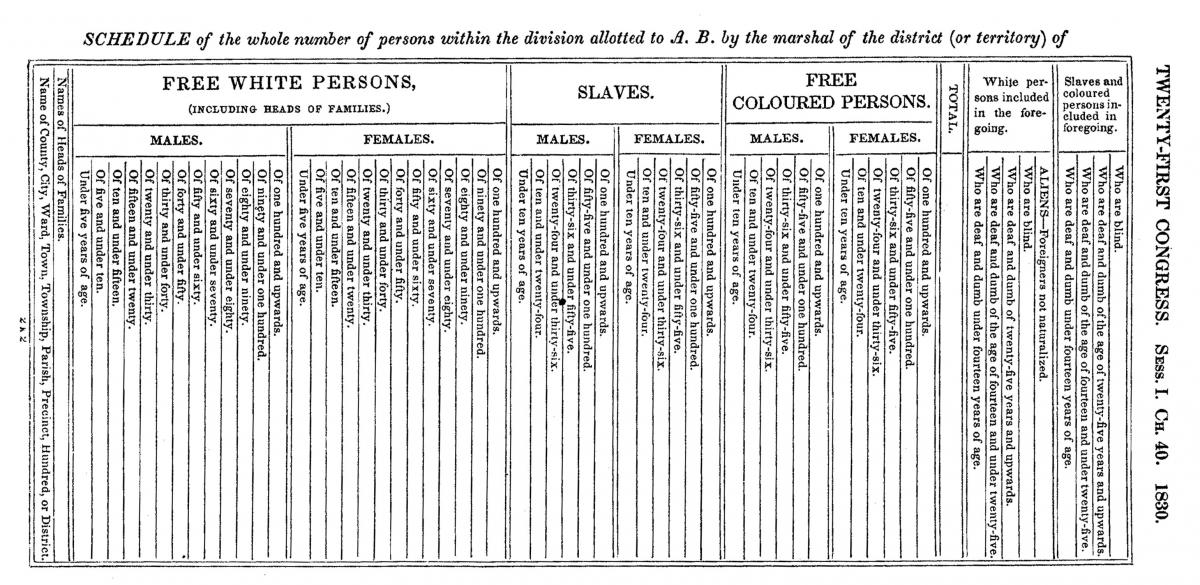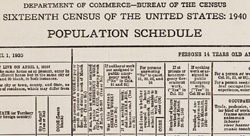
1830 Census Records
The 1830 population census was the Fifth Decennial Census of the United States. Taken every 10 years since 1790, census records provide a snapshot of the nation's population.
Frequently Asked Questions About the 1830 Census
Why was the 1830 Census taken?
Article I, Section 2, of the U.S. Constitution established that representation in the U.S. House of Representatives was based on population determined by a census taken at 10 year intervals: "The actual Enumeration shall be made within three Years after the first Meeting of the Congress of the United States, and within every subsequent Term of ten Years, in such Manner as they [Congress] shall by Law Direct."
What was the official census day?
Tuesday, June 1, 1830.
When was it taken?
The census began on Tuesday, June 1, 1830, and was finished within 6 months, under the rules and directions established in an Act of Congress approved March 23, 1830 ( “An Act to provide for taking the fifth census or enumeration of the inhabitants of the United States,” 4 Statutes at Large 383).
Who was counted?
The law required "That every person whose usual place of abode shall be in any family on [June 1, 1830], shall be returned as of such family; and the name of every person, who shall be an inhabitant of any district or territory, but without a settled place of residence, shall be inserted in the column of the schedule which is allotted for the heads of families, in that division where he or she shall be on [June 1, 1830], and every person occasionally absent at the time of the enumeration, as belonging to that place in which he usually resides in the United States."
Who was involved?
- Secretary of State Martin Van Buren had general supervision of census operations and tabulating and reporting the results to the President and Congress.
- The U.S. Marshal for each Federal judicial district was responsible for taking the census in his district with the help of assistant marshals whom he appointed. Each marshal took an oath or affirmation that "I will truly and faithfully cause to be made, a full and perfect enumeration and description of all persons resident within my district (or territory,) and return the same to the Secretary of State, agreeably to the directions of an act of Congress, entitled, 'An act to provide for taking the fifth census, or enumeration of the inhabitants of the United States,' according to the best of my ability." Each assistant marshal took an oath or affirmation that "I will make a just, faithful, and perfect enumeration and description of all persons, resident within the division assigned to me for that purpose ... and that I will take the said enumeration to the best of my ability, and that I will take the said enumeration and description, by actual inquiry at every dwelling-house within said division, or personal inquiry of the head of every family, and not otherwise."
- Every person over age 16 was required to cooperate: "That each and every free person, more than sixteen years of age, whether heads of families or not ... shall be, and hereby is, obligated to render to the assistant [marshal] of the division, if required, a true account, to the best of his or her knowledge, of every person belonging to such family ... on pain of forfeiting twenty dollars...."
What questions did the census ask?
- Free White Persons
- Name of head of family
- Number of free white males under 5 years of age
- Number of free white males of 5 and under 10 years of age
- Number of free white males of 10 and under 15 years of age
- Number of free white males of 15 and under 20 years of age
- Number of free white males of 20 and under 30 years of age
- Number of free white males of 30 and under 40 years of age
- Number of free white males of 40 and under 50 years of age
- Number of free white males of 50 and under 60 years of age
- Number of free white males of 60 and under 70 years of age
- Number of free white males of 70 and under 80 years of age
- Number of free white males of 80 and under 90 years of age
- Number of free white males of 90 and under 100 years of age
- Number of free white males of 100 years of age and upwards
- Number of free white females under 5 years of age
- Number of free white females of 5 and under 10 years of age
- Number of free white females of 10 and under 15 years of age
- Number of free white females of 15 and under 20 years of age
- Number of free white females of 20 and under 30 years of age
- Number of free white females of 30 and under 40 years of age
- Number of free white females of 40 and under 50 years of age
- Number of free white females of 50 and under 60 years of age
- Number of free white females of 60 and under 70 years of age
- Number of free white females of 70 and under 80 years of age
- Number of free white females of 80 and under 90 years of age
- Number of free white females of 90 and under 100 years of age
- Number of free white females of 100 years of age and upwards
- Slaves
- Number of male slaves under 10 years of age
- Number of male slaves of 10 and under 24 years of age
- Number of male slaves of 24 and under 36 years of age
- Number of male slaves of 36 and under 55 years of age
- Number of male slaves of 55 and under 100 years of age
- Number of male slaves of 100 years of age and upwards
- Number of female slaves under 10 years of age
- Number of female slaves of 10 and under 24 years of age
- Number of female slaves of 24 and under 36 years of age
- Number of female slaves of 36 and under 55 years of age
- Number of female slaves of 55 and under 100 years of age
- Number of female slaves of 100 years of age and upwards
- Free Colored Persons
- Number of free colored males under 10 years of age
- Number of free colored males of 10 and under 24 years of age
- Number of free colored males of 24 and under 36 years of age
- Number of free colored males of 36 and under 55 years of age
- Number of free colored males of 55 and under 100 years of age
- Number of free colored males of 100 years of age and upwards
- Number of free colored females under 10 years of age
- Number of free colored females of 10 and under 24 years of age
- Number of free colored females of 24 and under 36 years of age
- Number of free colored females of 36 and under 55 years of age
- Number of free colored females of 55 and under 100 years of age
- Number of free colored females of 100 years of age and upwards
- Total (in each household)
- White persons included in the foregoing
- Number who are deaf and dumb under 14 years of age
- Number who are deaf and dumb of 14 and under 25 years of age
- Number who are deaf and dumb of age 25 and upwards
- Number persons who are blind
- Number who are ALIENS--Foreigners not naturalized
- Slaves and colored persons included in the foregoing
- Number who are deaf and dumb under 14 years of age
- Number who are deaf and dumb of 14 and under 25 years of age
- Number who are deaf and dumb of age 25 and upwards
- Number persons who are blind
What did the census form look like?
The 1830 census was the first census for which the Federal Government provided blank printed forms to the U.S. Marshals. Congress required the format shown below. In addition, there may be annotations such as certificates of oaths taken and population totals. Later annotations include handwritten and mechanically-stamped page numbers.
What states and territories are included in the census?
Surviving records include census schedules for Alabama, Arkansas, Connecticut, Delaware, District of Columbia, Florida, Georgia, Illinois, Indiana, Kentucky, Louisiana, Maine, Maryland, Massachusetts, Michigan, Mississippi, Missouri, New Hampshire, New Jersey, New York, North Carolina, Ohio, Pennsylvania, Rhode Island, South Carolina, Tennessee, Vermont, and Virginia. Special notes:
- Alexandria County, Virginia, was part of the District of Columbia
- West Virginia was part of Virginia.
Are some 1830 census records missing?
Yes. There are no schedules for:
- Maryland - Montgomery, Prince George's, Saint Mary's, Queen Anne's, and Somerset Counties
- Mississippi - Pike County
- South Carolina - Clarendon County
It is possible that individual census pages for other locations were lost between 1830 and when they were bound in volumes in the early 1900s.
Where can I see the original 1830 census schedules?
Digital images of National Archives Microfilm Publication M19, Fifth Census of the United States, 1830 (201 rolls), can be seen on popular genealogy websites, including Ancestry.com, FamilySearch.org, and others.



